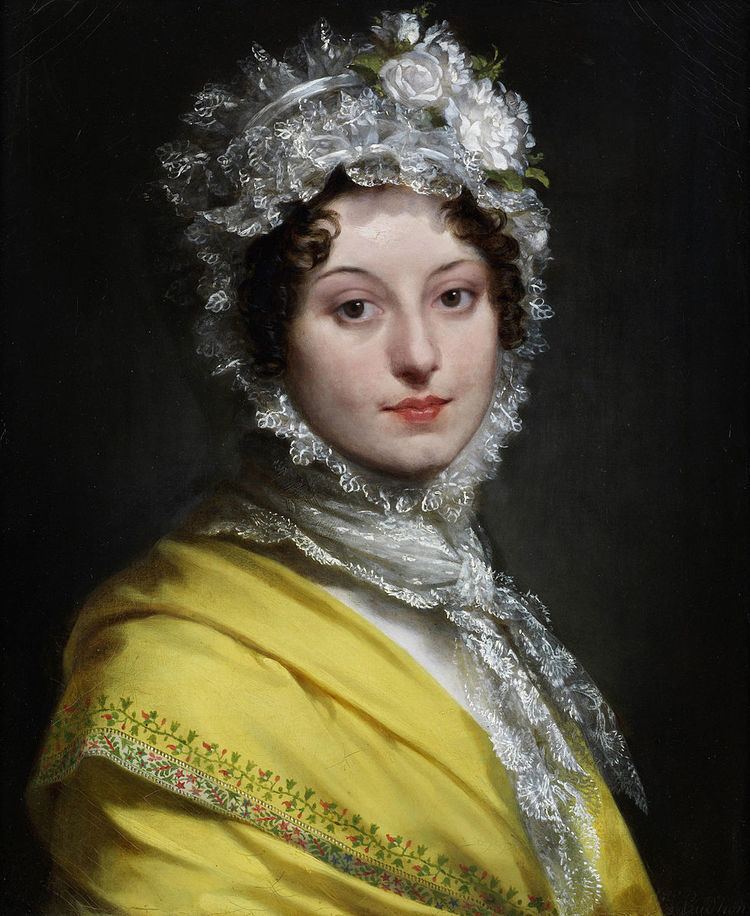 | ||
Première dame d'honneur ('First lady of honour'), or only dame d'honneur ('lady of honour'), was an office at the royal court of France. It existed in nearly all French courts from the 16th-century onward. Though the task of the post shifted, the dame d'honneur was normally the first or the second rank of all ladies-in-waiting. The dame d'honneur was selected from the members of the highest French nobility.
Contents
- History
- Dame dhonneur to Eleanor of Austria 1532 1547
- Dame dhonneur to Catherine de Medici 1547 1589
- Dame dhonneur to Mary Stuart 1559 1560
- Dame dhonneur to Elisabeth of Austria 1570 1574
- Dame dhonneur to Louise of Lorraine 1575 1601
- Dame dhonneur to Marie de Medici 1600 1632
- Dame dhonneur to Anne of Austria 1615 1666
- Dame dhonneur to Maria Theresa of Spain 1660 1683
- Dame dhonneur to Marie Leszczyska 1725 1768
- Dame dhonneur to Marie Antoinette 1774 1792
- Dame dhonneur to Josphine de Beauharnais 1804 1814
- Dame dhonneur to Marie Louise 1810 1814
- Dame dhonneur to Maria Amalia of Naples and Sicily 1830 1848
- Dame dhonneur to Eugnie de Montijo 1853 1870
- References
History
The office was created in 1523. The task of the dame d'honneur was to supervise the female courtiers, controlling the budget, ordering necessary purchases, and organizing the annual account and staff list; she supervised the daily routine, and attended ordinary as well as ceremonial court functions, as well as escorting and introducing those seeking audience with the queen. She had the keys to the queen's personal rooms in her possession.
When the dame d'honneur was absent, she was replaced by the dame d'atour, who normally had the responsibility of the queen's wardrobe and jewelry and the dressing of the queen.
In 1619, the office of the Surintendante de la Maison de la Reine, or only surintendante, was created. The surintendante had about the same tasks as the dame d'honneur: receiving the oath of the female personnel before they took office and supervising them and the queens daily routine, as well as organizing the accounts and staff list, but she was placed in rank above the dame d'honneur. Whenever the surintendante was absent, she was replaced by the dame d'honneur. The post of surintendante could be left vacant for long periods, such as between the death of Marie Anne de Bourbon in 1741 and the appointment of Princess Marie Louise of Savoy in 1775.
The term dame d'honneur has also been use as a term for a French lady-in-waiting in general. From 1523, the group of ladies-in-waiting attending the court as companions of the queen had the title dame d'honneur (commonly only 'dame'), hence the title 'Première dame d'honneur' ('First lady of honur') to distinguish between the chief lady in waiting and the remaining (married) ladies-in-waiting. In 1674, however, a reform replaced both the common married dame d'honneur or dames as well as the unmarried filles d'honneur ('maid of honour') or filles with the dame de palais.
The position of dame d'honneur was revived during the First Empire, were the principal lady-in-waiting to the empress had the same title.
During the Second Empire, the dame d'honneur had the same position as before, now formally second rank below a surintendante with the title Grande-Maitresse.
Dame d'honneur to Eleanor of Austria 1532-1547
Dame d'honneur to Catherine de' Medici 1547-1589
Dame d'honneur to Mary Stuart 1559-1560
Dame d'honneur to Elisabeth of Austria 1570-1574
Dame d'honneur to Louise of Lorraine 1575-1601
Dame d'honneur to Marie de' Medici 1600-1632
Dame d'honneur to Anne of Austria 1615-1666
For the first years in France, before her Spanish entourage was sent back to Spain, Anne had both a French and a Spanish office holder in several posts of her court.
